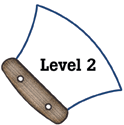|
National Science Education Standards
Employ simple equipment and tools to gather data and extend the senses.
In early years, students develop simple skills, such as how to observe,
measure, cut, connect, switch, turn on and off, pour, hold, tie, and hook.
Beginning with simple instruments, students can use rulers to measure
the length, height, and depth of objects and materials; thermometers to
measure temperature; watches to measure time; beam balances and spring
scales to measure weight and force; magnifiers to observe objects and
organisms; and microscopes to observe the finer details of plants, animals,
rocks, and other materials. Children also develop skills in the use of
computers and calculators for conducting investigations. (Page 122)
Use data to construct a reasonable explanation. This aspect of the standard
emphasizes the students’ thinking as they use data to formulate explanations.
Even at the earliest grade levels, students should learn what constitutes
evidence and judge the merits or strength of the data and information
that will be used to make explanations. After students propose an explanation,
they will appeal to the knowledge and evidence they obtained to support
their explanations. Students should check their explanations against scientific
knowledge, experiences, and observations of others. (Page 122)
Communicate investigations and explanations. Students should begin developing
the abilities to communicate, critique, and analyze their work and the
work of other students. This communication might be spoken or drawn as
well as written. (Page 122)
Technology used to gather data enhances accuracy and allows scientists
to analyze and quantify results of investigations. (Page 148)
Scientists develop explanations using observations (evidence) and what
they already know about the world (scientific knowledge). Good explanations
are based on evidence from investigations. (Page 123)
|
|
Benchmarks
Scientific investigations may take many forms, including observing what
things are like or what is happening somewhere, collecting specimens for
analysis, and doing experiments. Investigations can focus on physical,
biological and social questions. (Page 11)
Results of scientific investigations are seldom exactly the same, but
if the differences are large, it is important to try to figure out why.
One reason for following directions carefully and for keeping records
of one’s work is to provide information on what might have caused
the differences. (Page 11)
Scientists’ explanations about what happens in the world come partly
from what they observe, partly from what they think. Sometimes scientists
have different explanations for the same set of observations. That usually
leads to their making more observations to resolve the differences. (Page
11)
Offer reasons for their findings and consider reasons suggested by others.
(Page 286)
Recognize when comparisons might not be fair because some conditions
are not kept the same. (Page 299)
|


